Abstract
One reason that some people are prone to calcium oxalate nephrolithiasis is that they produce urine that is subnormal in its ability to inhibit the growth of calcium oxalate crystals. We have identified in human urine a glycoprotein (GCI) that inhibits calcium oxalate crystal growth strongly, and at low concentrations (10(-7) M); in this study, we have isolated GCI molecules from the urine of normal people and patients with calcium oxalate stones. GCI from stone formers is abnormal in three ways: it contains no detectable gamma-carboxyglutamic acid (Gla), whereas normal GCI contains 2-3 residues of Gla per mole; about half of the GCI in urine of patients inhibits crystal growth 4-20 times less than normal GCI as judged by its performance in a kinetic growth assay, in vitro; at the air-water interface, patient GCI has a film collapse pressure approximately half of normal. GCI molecules from the urine of patients with calcium oxalate nephrolithiasis are intrinsically abnormal, and these abnormalities could play a role in the genesis of stones.
Full text
PDF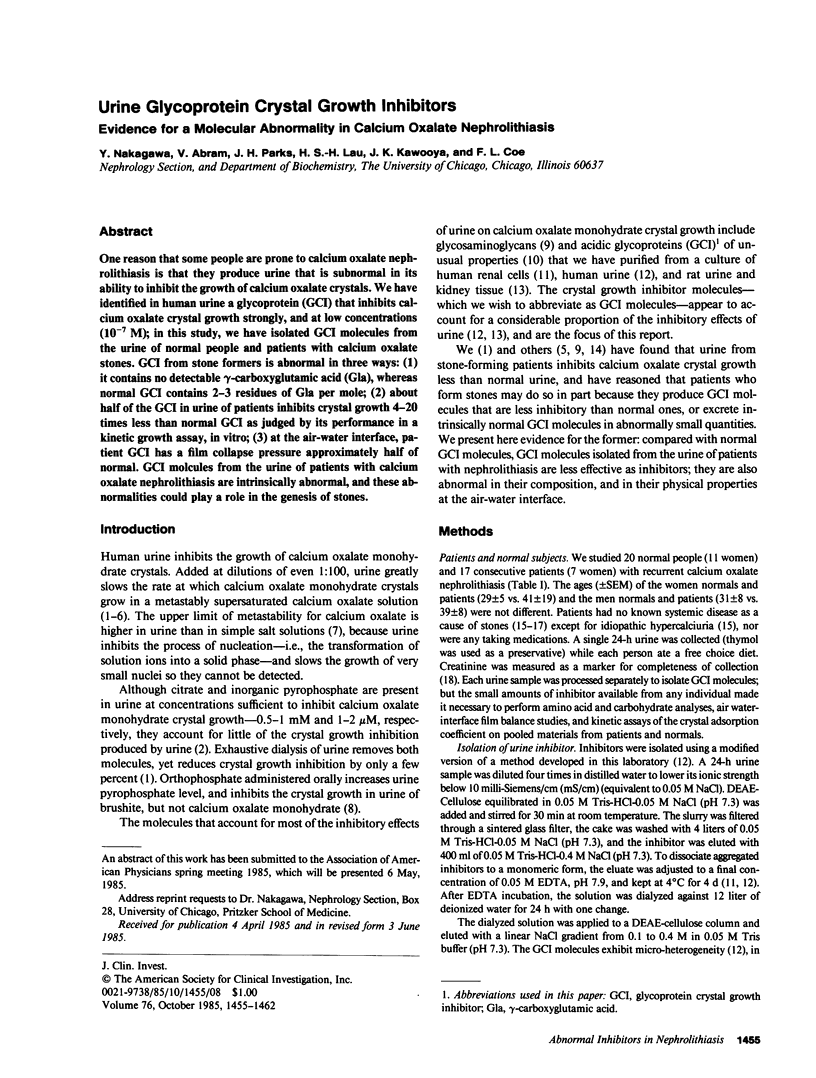
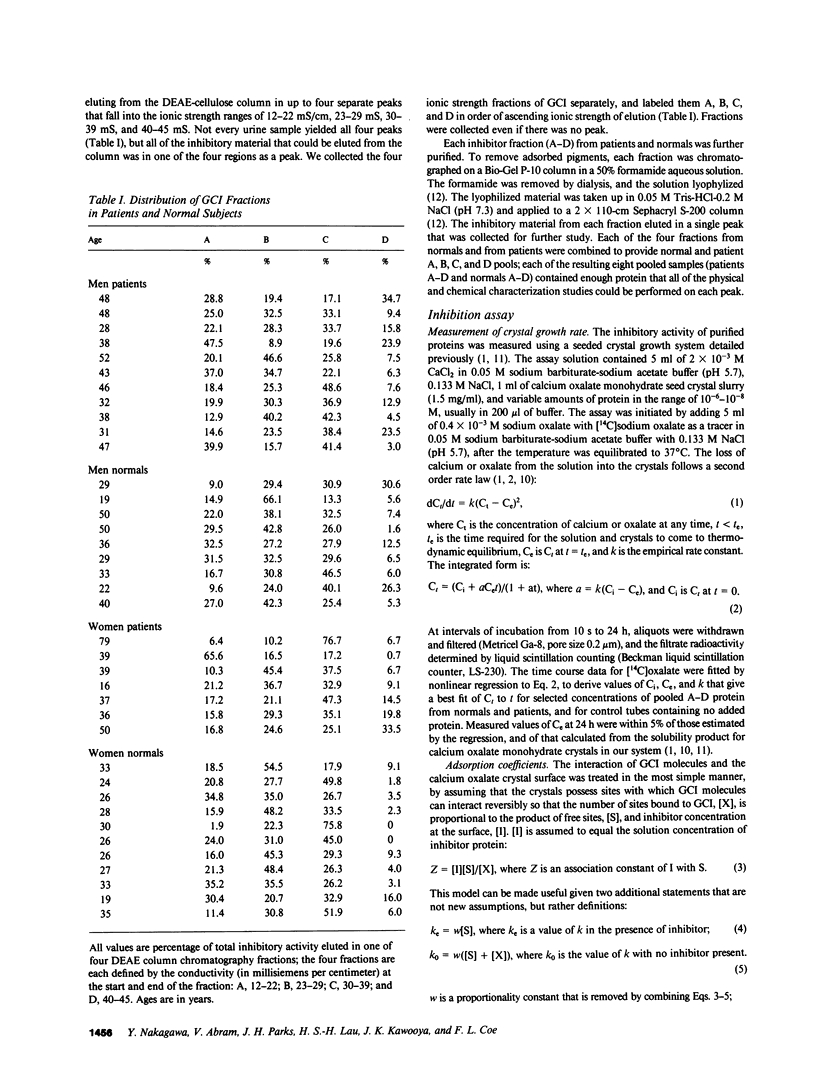
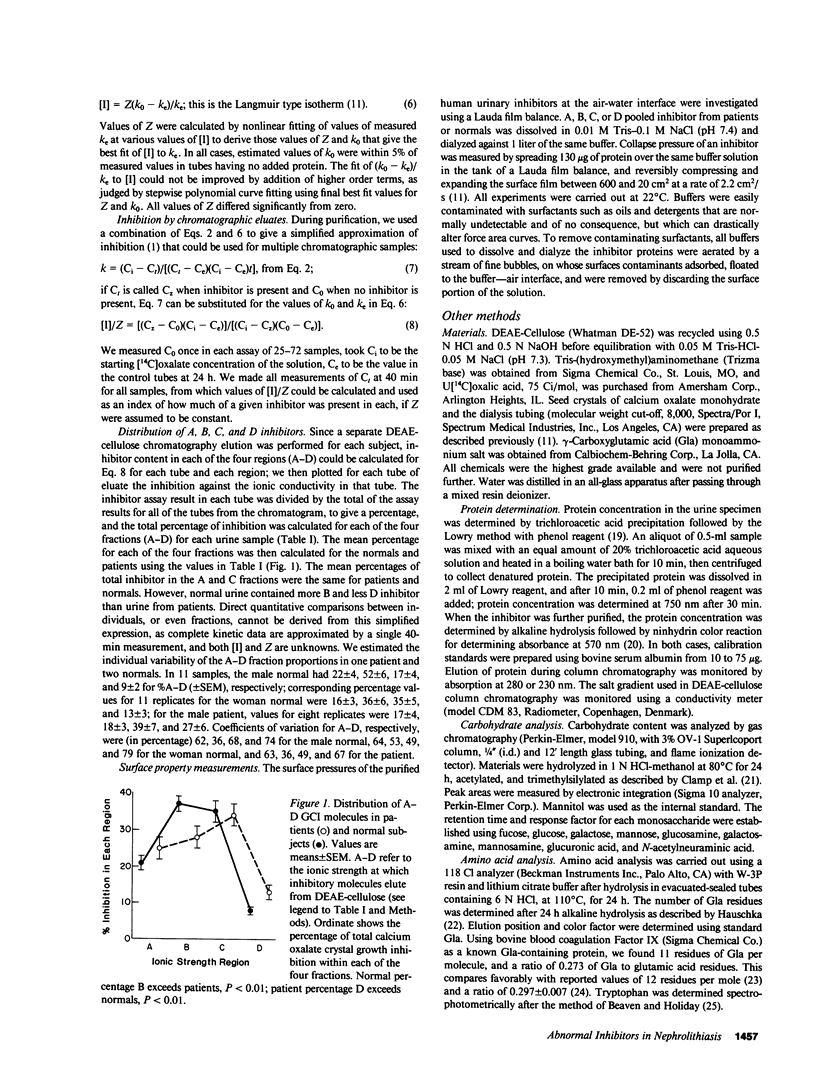
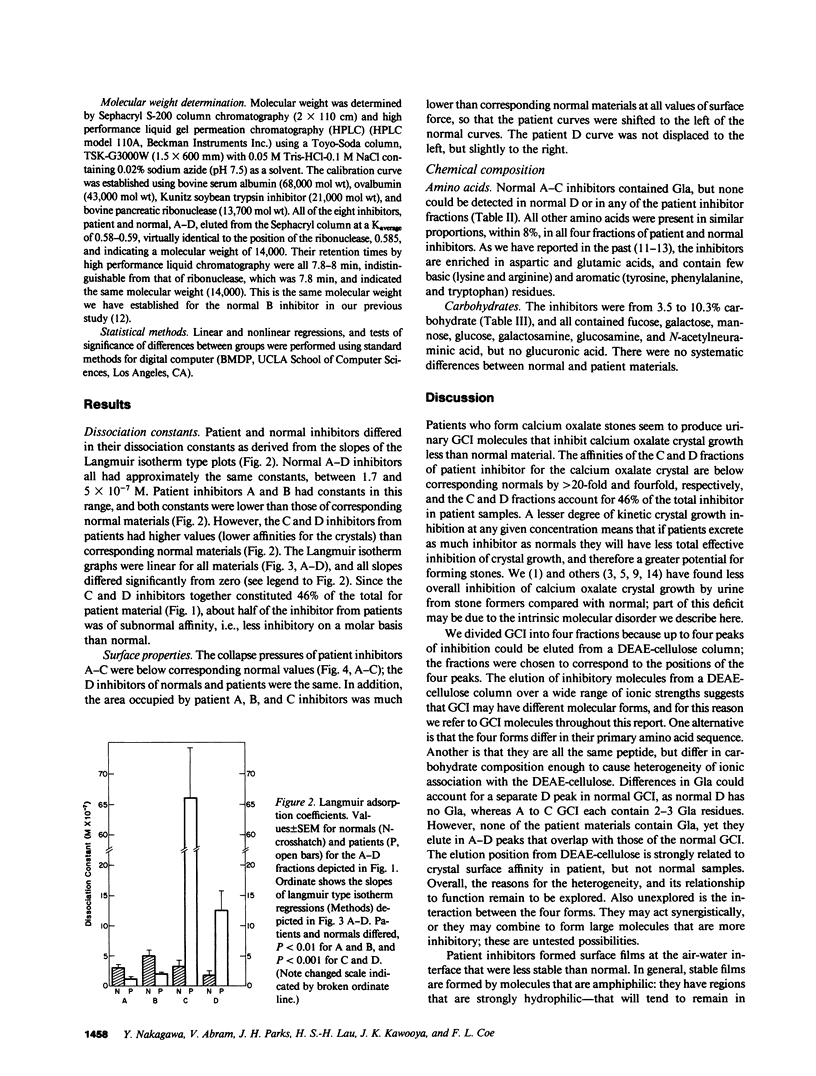

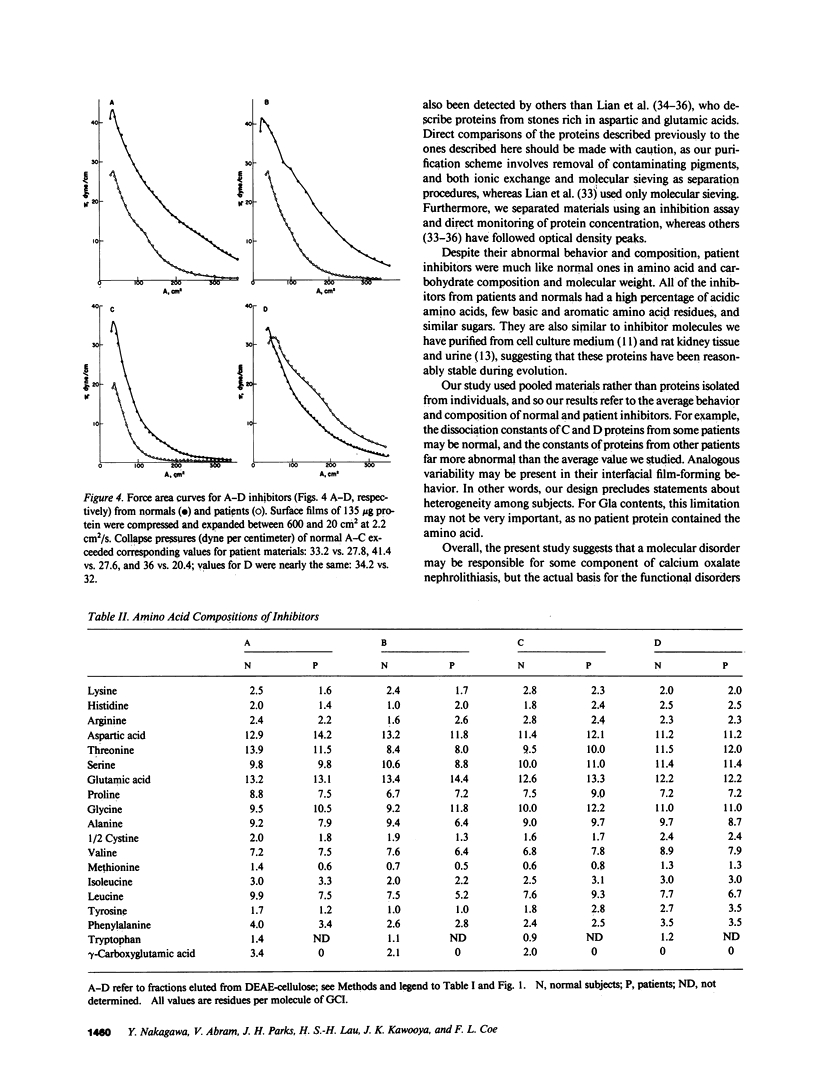
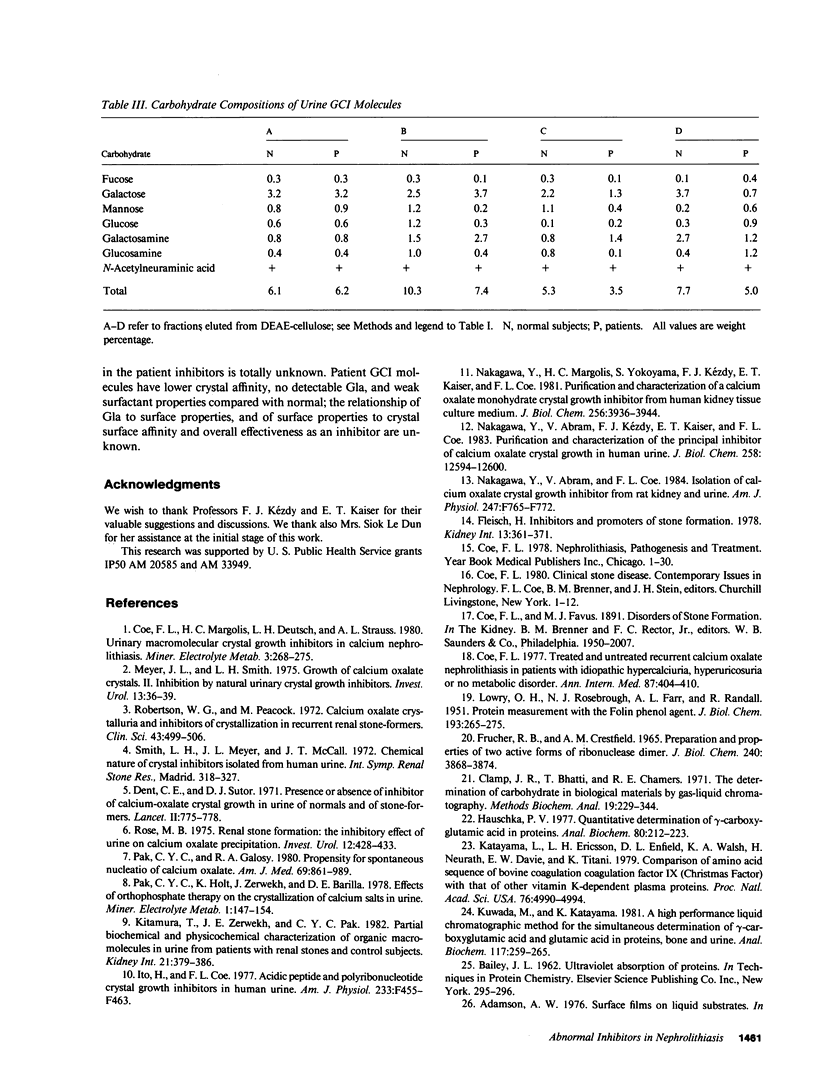
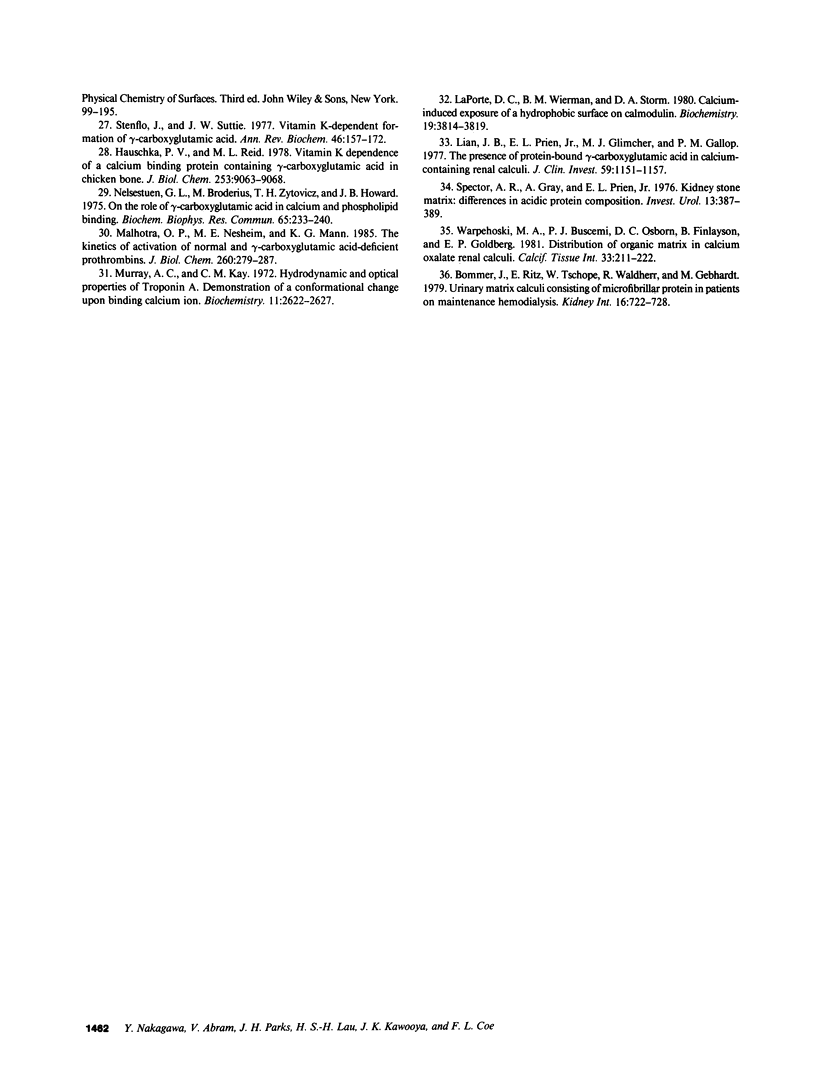
Selected References
These references are in PubMed. This may not be the complete list of references from this article.
- Bommer J., Ritz E., Tschöpe W., Waldherr R., Gebhardt M. Urinary matrix calculi consisting of microfibrillar protein in patients on maintenance hemodialysis. Kidney Int. 1979 Dec;16(6):722–728. doi: 10.1038/ki.1979.188. [DOI] [PubMed] [Google Scholar]
- Clamp J. R., Bhatti T., Chambers R. E. The determination of carbohydrate in biological materials by gas-liquid chromatography. Methods Biochem Anal. 1971;19:229–344. doi: 10.1002/9780470110386.ch3. [DOI] [PubMed] [Google Scholar]
- Coe F. L. Treated and untreated recurrent calcium nephrolithiasis in patients with idiopathic hypercalciuria, hyperuricosuria, or no metabolic disorder. Ann Intern Med. 1977 Oct;87(4):404–410. doi: 10.7326/0003-4819-87-4-404. [DOI] [PubMed] [Google Scholar]
- Dent C. E., Sutor D. J. Presence or absence of inhibitor of calcium-oxalate crystal growth in urine of normals and of stoneformers. Lancet. 1971 Oct 9;2(7728):775–778. doi: 10.1016/s0140-6736(71)92737-1. [DOI] [PubMed] [Google Scholar]
- Fleisch H. Inhibitors and promoters of stone formation. Kidney Int. 1978 May;13(5):361–371. doi: 10.1038/ki.1978.54. [DOI] [PubMed] [Google Scholar]
- Fruchter R. G., Crestfield A. M. Preparation and properties of two active forms of ribonuclease dimer. J Biol Chem. 1965 Oct;240(10):3868–3874. [PubMed] [Google Scholar]
- Hauschka P. V. Quantitative determination of gamma-carboxyglutamic acid in proteins. Anal Biochem. 1977 May 15;80(1):212–223. doi: 10.1016/0003-2697(77)90640-6. [DOI] [PubMed] [Google Scholar]
- Hauschka P. V., Reid M. L. Vitamin D dependence of a calcium-binding protein containing gamma-carboxyglutamic acid in chicken bone. J Biol Chem. 1978 Dec 25;253(24):9063–9068. [PubMed] [Google Scholar]
- Ito H., Coe F. L. Acidic peptide and polyribonucleotide crystal growth inhibitors in human urine. Am J Physiol. 1977 Nov;233(5):F455–F463. doi: 10.1152/ajprenal.1977.233.5.F455. [DOI] [PubMed] [Google Scholar]
- Katayama K., Ericsson L. H., Enfield D. L., Walsh K. A., Neurath H., Davie E. W., Titani K. Comparison of amino acid sequence of bovine coagulation Factor IX (Christmas Factor) with that of other vitamin K-dependent plasma proteins. Proc Natl Acad Sci U S A. 1979 Oct;76(10):4990–4994. doi: 10.1073/pnas.76.10.4990. [DOI] [PMC free article] [PubMed] [Google Scholar]
- Kitamura T., Zerwekh J. E., Pak C. Y. Partial biochemical and physicochemical characterization of organic macromolecules in urine from patients with renal stones and control subjects. Kidney Int. 1982 Feb;21(2):379–386. doi: 10.1038/ki.1982.33. [DOI] [PubMed] [Google Scholar]
- Kuwada M., Katayama K. A high-performance liquid chromatographic method for the simultaneous determination of gamma-carboxyglutamic acid and glutamic acid in proteins, bone, and urine. Anal Biochem. 1981 Nov 1;117(2):259–265. doi: 10.1016/0003-2697(81)90720-x. [DOI] [PubMed] [Google Scholar]
- LaPorte D. C., Wierman B. M., Storm D. R. Calcium-induced exposure of a hydrophobic surface on calmodulin. Biochemistry. 1980 Aug 5;19(16):3814–3819. doi: 10.1021/bi00557a025. [DOI] [PubMed] [Google Scholar]
- Lian J. B., Prien E. L., Jr, Glimcher M. J., Gallop P. M. The presence of protein-bound gamma-carboxyglutamic acid in calcium-containing renal calculi. J Clin Invest. 1977 Jun;59(6):1151–1157. doi: 10.1172/JCI108739. [DOI] [PMC free article] [PubMed] [Google Scholar]
- Malhotra O. P., Nesheim M. E., Mann K. G. The kinetics of activation of normal and gamma-carboxyglutamic acid-deficient prothrombins. J Biol Chem. 1985 Jan 10;260(1):279–287. [PubMed] [Google Scholar]
- Meyer J. L., Smith L. H. Growth of calcium oxalate crystals. II. Inhibition by natural urinary crystal growth inhibitors. Invest Urol. 1975 Jul;13(1):36–39. [PubMed] [Google Scholar]
- Murray A. C., Kay C. M. Hydrodynamic and optical properties of troponin A. Demonstration of a conformational change upon binding calcium ion. Biochemistry. 1972 Jul 4;11(14):2622–2627. doi: 10.1021/bi00764a012. [DOI] [PubMed] [Google Scholar]
- Nakagawa Y., Abram V., Coe F. L. Isolation of calcium oxalate crystal growth inhibitor from rat kidney and urine. Am J Physiol. 1984 Nov;247(5 Pt 2):F765–F772. doi: 10.1152/ajprenal.1984.247.5.F765. [DOI] [PubMed] [Google Scholar]
- Nakagawa Y., Abram V., Kézdy F. J., Kaiser E. T., Coe F. L. Purification and characterization of the principal inhibitor of calcium oxalate monohydrate crystal growth in human urine. J Biol Chem. 1983 Oct 25;258(20):12594–12600. [PubMed] [Google Scholar]
- Nakagawa Y., Margolis H. C., Yokoyama S., Kézdy F. J., Kaiser E. T., Coe F. L. Purification and characterization of a calcium oxalate monohydrate crystal growth inhibitor from human kidney tissue culture medium. J Biol Chem. 1981 Apr 25;256(8):3936–3944. [PubMed] [Google Scholar]
- Nelsestuen G. L., Broderius M., Zytkovicz T. H., Howard J. B. On the role of gamma-carboxyglutamic acid in calcium and phospholipid binding. Biochem Biophys Res Commun. 1975 Jul 8;65(1):233–240. doi: 10.1016/s0006-291x(75)80084-2. [DOI] [PubMed] [Google Scholar]
- Robertson W. G., Peacock M. Calcium oxalate crystalluria and inhibitors of crystallization in recurrent renal stone-formers. Clin Sci. 1972 Oct;43(4):499–506. doi: 10.1042/cs0430499. [DOI] [PubMed] [Google Scholar]
- Rose M. B. Renal stone formation. The inhibitory effect of urine on calcium oxalate precipitation. Invest Urol. 1975 May;12(6):428–433. [PubMed] [Google Scholar]
- Spector A. R., Gray A., Prien E. L., Jr Kidney stone matrix. Differences in acidic protein composition. Invest Urol. 1976 May;13(6):387–389. [PubMed] [Google Scholar]
- Stenflo J., Suttie J. W. Vitamin K-dependent formation of gamma-carboxyglutamic acid. Annu Rev Biochem. 1977;46:157–172. doi: 10.1146/annurev.bi.46.070177.001105. [DOI] [PubMed] [Google Scholar]
- Warpehoski M. A., Buscemi P. J., Osborn D. C., Finlayson B., Goldberg E. P. Distribution of organic matrix in calcium oxalate renal calculi. Calcif Tissue Int. 1981;33(3):211–222. doi: 10.1007/BF02409440. [DOI] [PubMed] [Google Scholar]


